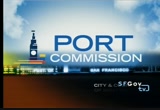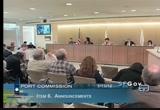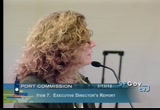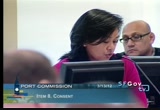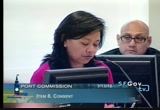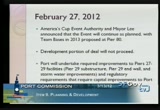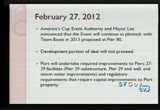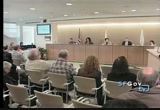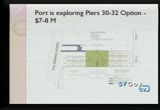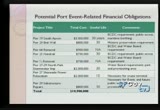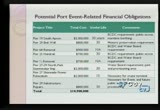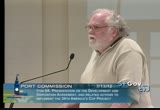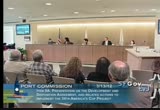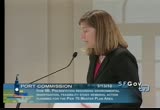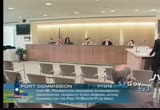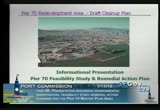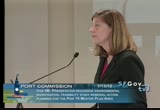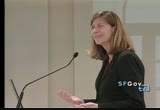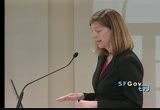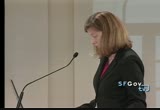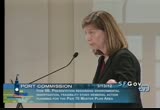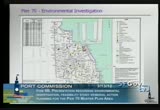tv [untitled] March 23, 2012 9:30am-10:00am PDT
9:30 am
>> roll call. item two, approval of minutes for february 28, and march 2, 2012 meeting. >> moved. >> second. >> the motion to move to executive session? any public comment on executive session? if>> reconvene in open session. move that we do not discuss those things discussed in executive session. >> second.
9:31 am
>> all in favor? >> aye. >> ok, please be advised the ringing of and use of cell phones and similar electronic devices are prohibited at this meeting. please be advised that the chair may order the removal of any person responsible for use of a cellphone, pagers, or other similar electronic device. please be advised that a member of the public has up to three minutes to make pertinent public comment on each agenda item unless the agenda adopts a shorter amount on any item. >> good afternoon, commissioners and members of the public, thank you for joining us today. i have one unanticipated item, which is to announce a meet and greet. demolition has begun at pier 27 for the long-awaited crews a terminal.
9:32 am
we would like to host of meet and greet with our neighbors, and we have scheduled that for march 20, which is next week at 3:30 p.m. at pier 29.5, right near the job site. that meet and greet will be hosted by the host of san francisco and cars -- in concert with our partner, department of public works and turner construction. if you would like more information, you can look at our website i assume. we would love to have anybody who would like to come. that concludes my report. 3:30 p.m. >president whoo ho: ok. any public comment? >> 8a authorization to request
9:33 am
authorization soliciting contracts for engineering and related professional services in the amount of 1.5 million, totaling $4.5 million. request approval of policy for capital funding expenditures. item eight c, request approval of a 60 month lease, lease #l- 14819, which contains a 60 month extension option between the port, as landlord, and r. buraak storage of limited, as a tenant for approximately 274163 square feet of paid we indicated at 600 amador street of cargo way at third street, which comprises a portion of see what three of record for in such leases also said it to approval by the board of supervisors.
9:34 am
president whoo ho: any public comment? any questions? resolutions 12.21, 22 and 23 have been approved. >> 9a, verbal information presentation on the development and it is position agreement and related actions to implement the 34th america's cup project involving use and appears nine, 19, 19.523, 27-29, and 29.5 and adjacent water areas. >> good afternoon. brad benson, working on the team representing the america's cup project. since we last spoke to you, a lot has happened.
9:35 am
you have seen this play out in the paper with the america's cup project. we regret we did not have an opportunity to get a written report to you today, but we wanted to provide a verbal report to the commission about where things stand with america's cup planning, and where we expect things to go over the next several weeks. as you know, on february 27, the america's cup authority and mayor lee announced the event will continue as planned in 2012-2013, but with the proposed move of the team industrial bases to tpier 80. as you will recall, the world series events planned in 2012, we're looking to pier 80 as the site to host team bases. the development portion of the deal that we have been working on over the past year will not proceed, and as a result, we
9:36 am
expect more discreet investment in the waterfronts, and we are not looking to development agreements to repay that investment. instead, the port would undertake the required improvements to pier 27-29 complex, which would continue to be the america's cup village and the main viewing area. those improvements would include the pier 29 at substructure, which needs repairs. pier 29 and wa end wall will neo be finished off. certain storm water improvements to the site, and other regulatory requirements. as you will recall, a number of public access and removal projects up and down the waterfront. the revised deal, the port would undertake the costs .
9:37 am
we are looking at the space planned for the event. the proposal to move it to 80. the moves it to the waterfront that is a little less accessible. staff has been looking at whether or not we can revise the idea of having the team industrial bases at pierce 30- 32, but with a lesser, more- focused investment at the site. so a little bit of a plant-level view of a program that support staff and engineering group has been working on in consultation with the event authority. it is hard to see the diagram here, but you will see the embarcadero. part of the problem is it does not allow truck access to the site. we think there is a way to build truck access, which you see and
9:38 am
purple, on the site out onto the pier, and to improve the deck in a manner that could house up to five team industrial bases at the site with overflow. we have done some engineering cost estimation, but the port engineers and event authorities, and we believe the cost of the plan would be 7 million-8 million. the benefit of this approach is that the site really is a great site for crewuise activity. the east face a 22 is a natural water birth. we would like to be able to get buses out to the end of the pier to pick up passengers, and to again, have limited truck access. so this is a set of improvements that it's a lot
9:39 am
more affordable than the plan we saw before that would provide 14 industrial bases during the america's cup, but have a long- term value to the port as well. i wanted to make sure the commission and the public understood 30-32 was potentially in play as part of the state's plan. i mentioned earlier some of the costs that we think the port might undertake under the revised agreements. i would just mention a few of them, rather than going everything -- going over everything on the slide. $10.9 million worth of costs on the slide. we would do apron improvements to peers out 19. a number of removal projects a pier 64. between the pier 1 and the very building. the new end wall at 29 and storm
9:40 am
water improvements at the end of pure 27-29, and relocating short power. that was another obligation that was on the event authority side of the location. as well as pier 29 substructure repairs i mentioned earlier. most of the improvements have a useful life of 30 years. they are good, capital investments. we have gone through the investments of scoring the projects using the port capital plan scoring process, and they all score quite well. they fulfill a number of either permitting and regulatory obligations or other port- mission oriented goals such as maritime breathiirthing and the. the port has sufficient deck
9:41 am
capacity to finance these obligations, largely because the poor will retain a lot of the properties that would have been leased on a long-term basis to the event authority, so we're seeing the port said capacity is growing from $65 million to $89 million. largely off because we will keep the rents in a long-term. the added capacity would be the source of funds to finance improvements i just talked about. inow i would like to go over the next steps. it has been a busy month and will continue to be a busy month. we are continue to engage in negotiations on the reduce footprint. we're having to go back to some of the regulatory partners and
9:42 am
explain changes that have happened over the past several weeks, and that will start with a hearing this thursday, march a 15 in oakland. in consultation with the city, we will be filing a revised lease disposition agreement with the board of supervisors for their consideration, and the board of supervisors committee of the whole continued its deliberations to march 27, so staff will attend that meeting. then we would propose a port commission action on either march 27 or april 10, concurrent with the board action or following board action. that is the update i have a. ports that are available to answer any questions, as well as mark martin.
9:43 am
president whoo ho: thank you. public comment. we have andrea taber. >> i guess i am here as the living proof of what the investment in the america's cup would mean for our city. i am a small business owner, minority business owner operating in the printing and paper space. i have been in dialogue with the america's cup for over five months now talking about how we can bring sustainable material to all of their marketing material, and all of the sign it. moving forward with this plan would allow me to grow my business, bringing on additional resources, bringing on additional economic development through to our first city. i urge you to concur with what they are asking you to decide
9:44 am
on. thank you. president whoo ho: norman appeapierce. >> norman pierce. i am a long-term san francisco resident and ownboat ownder. ier. i am in support of the effort to make this event happened in san francisco. we had a heck of, but just a hiccup. i think this revised plan that i first saw today and any concerns about pier 32 is appropriate, because it brings back the concept of the village. having been too numerous america's cups, the ones that were most successful were the ones that created a village environment for people to interact, and not just for
9:45 am
sailors. this event is being marketed to more than just sailors. it is going to help the citizens of san francisco, the citizens of the bay area. it will help us beginning a restructuring of our court harbour facilities into more recreational facilities, and i want to commend everybody for hanging in there really hard with the long, drawn out granite street pier project that i just drove by today and they're taking out. it is going to be gone. we can have more good, positive work earne. you have a great partner. it was just a hiccup, but we are ready to move forward.
9:46 am
thank you. president whoo ho: any further public comment? commissioners, comments? i want to clarify since we have had discussion on this that the consensus in the presentation, there was contention with a 4.9 million. we think this investment, and the commission is certainly supportive of looking at the idea of moving the bill which to peer 30-32 for the other teams, and we support the direction you heard in the information presentation. >> i would like to chime in and say thanks staff for being nimble. i know it was not easy. thank you for your due diligence. >> likewise. i know an incredible amount of effort was put in under the
9:47 am
prior reiteration come and hopefully some of that was useful. we want to thank staff for being so vigilant. thank you. >> i'm going to thank the staff , too. [laughter] and mike martin. you guys have done an incredible job and have really been there to move this forward. thank you for making this continue to happen. >> i don't want to be the silent one. i concur with what my colleagues have said and continue to have respect and admiration for the continuing efforts that make this happen in one form or another. >> we will continue to be as creative as we can for the short-term and long-term for the city and the future of the port of san francisco. thank you. >> item 9b, informational
9:48 am
presentation regarding environmental investigation come a feasibility study of the potential remedial action and remedial action planning for the pier 70 master plan area, located east of illinois street between mariposa and 22nd streets. >> i'm carol bach, feared provincial affairs director in the port commission. i appreciate the opportunity to present this to you today and bring you up-to-date on the environmental investigation and remedial action plan work we have been doing up here 70. my presentation is precipitated in large part by the imminent publication of a feasibility study and remedial action plan to addressed contaminants to peer 70. -- to pier 70.
9:49 am
i am aware that three of the five of you are new to the commission since the last of my updated you. i will give you a little bit of background on what we've been doing for the past five years before i get to this. manny, you will have to help me out on this slides. you are aware from it -- thank you. i am sure you are aware from what you've heard of site history through the master plan development that app pier 70 has been under heavy industrial use for the past 100 years, including several decades when the united states navy was occupying part of this for shipbuilding and repair activities.
9:50 am
and additionally, the way that much of the land that comprises pier 70 came to be was material in the bay to create new land. historically the story line was comprised of serpentine rock bluff overlooking mud and the early developers created new shoreline land, at least in the pier 70 area, blasting the rock bluff and pushing the rock and debris onto the mud flats. additional material was placed to create new land of material as well. as a result of the way the soil that makes up here 70 came to exist, the material that was used to create it and a long
9:51 am
history of industrial operations, there are many significant sources as contaminants there, and as a result, there has always been uncertainty about what was out there, what it would take to mediate it, and how much the radiation at -- mediation would cost and how would impact for future development. with an awareness of those issues, and 2007 thin 2007 the sought a development with the support of the mayor's office and congress woman pelosi's office, that was awarded to the port through the u.s. department of commerce's economic development administration in late 2008.
9:52 am
the grant award was for 2.2 $8 million to be used to investigate and clean up environmental contaminants at pier 70, including ground and water contamination and hazardous building materials. we began with the soil and groundwater investigation in 2009 that continue 2010, and we publish the site investigation report in 2011. this figure shows an earlier version of the parcel scheme that was outlined in a draft port master plan for pure 70. the reason i bring it up is that was the plan that was in existence when we began this site investigation. all of our soil samples and
9:53 am
references to location within herpier 70 are based on a persol location. since then, the site has evolved and not reflected in the final preferred master plan, but for consistency with the way we identified locations in the investigation we have carried forward this schema through this. if you ever read the whole document, you will see references to parcel nine. if you know the master plan, you may think there is no person mind, but that is why. -- no parcel 9, but that is why. the shows the soil gas sample locations come and show it not because i expect you to define any information about environmental conditions from it, but to show that we sought to get a broad coverage of conditions that exist throughout the entire site, and we also
9:54 am
based this investigation on historic data. there have been many previous investigations, so we looked at the old data, check it for validity, and combined it with new examples we have to elected to fill in data gaps, and also to get broad coverage throughout the site. the site investigation concluded more than 180 soil samples from borings that were drilled to various steps throughout the site and from test pits, shallowed of excavations. we collected more than 50 ground water samples from temporary sampling locations, and also from 10 a permanent ground water monitoring wells. we collected 33 soil samples. the reason soil gas is interesting is because soil gas,
9:55 am
the air that exist in the spaces within subsurface soil can migrate up through foundations into buildings, and also can migrate into outdoor air. if you of volatile organic compounds in soil gas, those can pose a potential health risk if they migrate into inclosed buildings. that is why we were looking at that. so ho thethis site investigation produced four key findings. it is containing metals, prh's, are particularly problematic class of hydrocarbon, at concentrations exceeding cleanup levels throughout the entire
9:56 am
site. those contaminants are from naturally occurring sources such as the serpentine rock that was used to create the land, and also historic industrial operations. those exceeded cleanup levels for all of the three different anticipated future uses, which would be commercial, recreational, and residential. virtually everywhere. conversely, ground water was found to contain metals and petroleum hydrocarbons. at concentrations it did not propose a human health impact or held to the environmenimpact to we found a couple of constituents above clean up level at different locations throughout the site, some of which were not confirmed through repeat sampling. there is really no indication we
9:57 am
have a problem with soil gas at pier 70. the human health risk estimate, which was conducted in conjunction with the site investigation found the greatest hazards associated with environmental contamination or future site users, the commercial, recreational, and residential users exposure to native soil and construction workers' exposure to soil, and potentially ground water because there excavating in an area and it to a depth where they would encounter ground water. a couple of exceptions to the general conclusion about ground water not being a problem, is within parcel 9, which are like chile -- which are largely operated by a ship operating, we found in the ground water intermittently in that area,
9:58 am
they would have residual petroleum, a very thick material that would be suspended in the water sample, and beside the investigation did additional analysis of the physical and chemical nature of that material and determined it is a heavily degraded petroleum material, probably related to historic fuel storage at the site. the presence of fuel in this of service in that area is documented as far back as 1930 and previous. we suspect that what remains is the last of the degradation of that material. it is not always told. it is not soluble. the petroleum constituents are not getting into the ground water. they are staying in this discreet molecule's. it could not be physically extracted, and it is not indicative of an ongoing source of petroleum.
9:59 am
we did not find it in the soil in the same area. the general conclusion about that material is that it does not pose a health risk and is not migrating to the bay, but it excavation were to occur in that area, special handling measures would be applied. and in the southeast corner of the site, the area shown on the slide as the blue polygon, there is an area referred to in the site investigation and the document as the mtp area. this is a portion of pier 70 where the contamination form -- from the formerly manufactured gas plant had migrated from beneath the plant site of north fort and now are present in the pier 70. in
58 Views
IN COLLECTIONS
SFGTV: San Francisco Government Television Television Archive
Television Archive  Television Archive News Search Service
Television Archive News Search Service 
Uploaded by TV Archive on

 Live Music Archive
Live Music Archive Librivox Free Audio
Librivox Free Audio Metropolitan Museum
Metropolitan Museum Cleveland Museum of Art
Cleveland Museum of Art Internet Arcade
Internet Arcade Console Living Room
Console Living Room Books to Borrow
Books to Borrow Open Library
Open Library TV News
TV News Understanding 9/11
Understanding 9/11